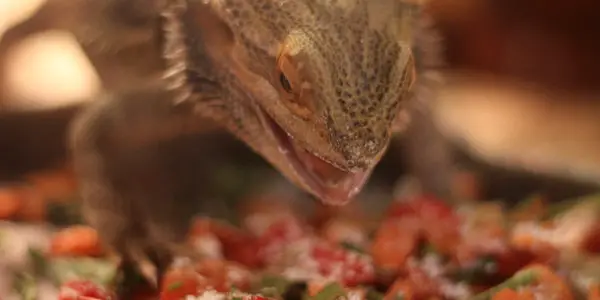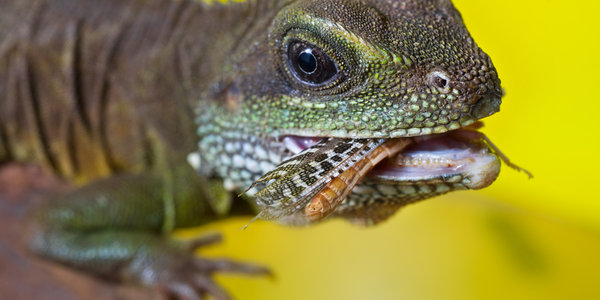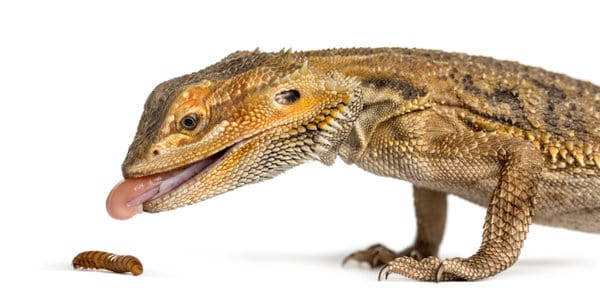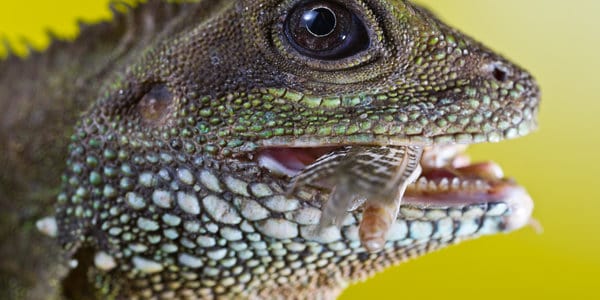Bearded dragons are omnivorous and thus rely on two types of food their entire lives; plants and insects. However, their dietary needs will vary as they grow older, affecting the proportions needed.
Owning a pet is often a great experience, especially for first-timers. The feeling, however, doesn’t last long once you realize that you have no idea what to feed your pet.
Before you decide on which pet to keep, it is important to learn as much as possible about them. Doing so will give you an easier time taking care of the pet.
A bearded dragon is one of the pets that most people love keeping. It has an advantage over other pets because it is easy to care for since it has minimal needs, from its diet to medical care.
With the proper knowledge and tools, you will have an easier time taking care of a bearded dragon than with most other pets.
To effectively take care of your bearded dragon, one of the things that you need to get right is their diet. It is crucial to know the correct type of food to give the lizard, when to feed them and what proportions.
A proper bearded dragon diet will help avoid various developmental problems and other diet-related issues. Below we get to discuss all matters about the bearded dragon’s diet.
How to Feed Your Bearded Dragon?
Bearded dragons are omnivorous and thus rely on two types of food their entire lives; plants and insects. However, their dietary needs will vary as they grow older, affecting the proportions needed.
Knowing which proportions to give your bearded dragon is vital for healthy growth and development at every stage.
Apart from plants and insects, you may also need to give your beardie calcium supplements and other multi-vitamins, further aiding proper development. Failure to supplement your bearded dragons diet with calcium may result in diet-related diseases like metabolic bone disease.
In the early stages of development, your beardie requires a more protein diet since their body is still developing. As they grow older, their body matures, and the need for a bodybuilding diet decreases.
Therefore, when your bearded dragon is younger, you need to give it a lot of insects to provide the required protein. As they grow older, you can gradually switch to a plant-based diet.

What Can Bearded Dragons Eat?
Insects are the main source of a bearded dragon’s proteins. Some of the best insects most people recommend for bearded dragons include; roaches, crickets, mealworms, butter worms, super worms, hornworms, and silkworms for adult bearded dragons.
For the plants, it is best that you mainly feed your beardies with leafy vegetables such as turnip greens, mustard greens, collard greens, dandelion greens, okra, squash, bell peppers, kale, cucumber, sweet potato, and pumpkins. It is worth noting that not all leafy greens are safe for consumption by bearded dragons.
For the non-leafy plants, you should cut them into tiny pieces or grate them to avoid the risk of your beardie choking. It also makes it easier for your beardie to eat the food. Alternatively, you may consider cooking them slightly to soften them up.
Apart from knowing the best food for your beardie, it is equally crucial to know what to avoid when feeding them. Some foods may look safe for feeding your dragon, but they can potentially harm them.
Unsafe foods for beardie’s diet include; dairy products, red meat, poultry, seafood, onions, spinach, rhubarb, and avocado. Salt, oil, pepper, and such additives are also toxic to the lizard.
It would be best to avoid feeding wild live insects to your bearded dragons as they may carry parasites and diseases that harm your pet.
For plants and fruits, always wash them thoroughly before feeding your bearded dragon. It helps eliminate insecticides and other chemical residues that may harm your pet.
What Food Proportions Should You Give Your Bearded Dragon?
As earlier mentioned, bearded dragons have varying dietary needs in both the type and proportions as they grow older.
For this reason, it is essential to know when and what to feed bearded dragons and in what proportions. It will help you avoid overfeeding your pet and also know when they are not eating effectively.
Here’s a brief breakdown of the right proportions to give the beardie as per their life stage.
Baby Bearded Dragons
At a young age, your reptile needs more proteins than plants because of their body’s high growth and development needs.
At about three months or younger beardie, their diet should compose at least 75% of insects, and the rest should come from plants and fruits.
In terms of feeding frequency, you should give the baby dragons food five times every day for the first three months of their lives.
Each feeding session should last for ten minutes. Allow your dragon to feed as much as they can in the ten minutes, after which you withdraw the food.
It is crucial to observe these feeding durations to avoid overfeeding the pet. Overfeeding your bearded dragon may be dangerous, as it can lead to obesity and interfere with your bearded dragon proper development.
Juveniles
When aged above three months, your beardie will have tremendous development in size and weight. At this stage, their need for proteins will decrease significantly, allowing you to cut back on the number of insects that you feed bearded dragons.
From the fourth month onwards, the recommendation is that you feed your bearded dragon equal proportions of live and dead insects to plants.
Regarding the frequency of feeding, young juveniles should feed four times a day, ten minutes each feeding. Depending on their needs and size, the frequency should be reduced to two or three times each day as they mature.
READ MORE: 15 Tips For Feeding and Caring For 6 Month Old Bearded Dragon!
Adult Bearded Dragons
Bearded dragons attain sexual maturity between eighteen and twenty months. At this point, they have minimal demand for proteins.
The composition of their diet at this age is 75% plant and 25% insects. It is essential to spice up their diet with fruits from time to time. You should mix fruits with their normal plant serving to make their meals more desirable.
The ideal feeding frequency for adult bearded dragon should be two times every day, preferably in the morning and early evening.
The rest of the time should be used to bask in the sun and exercise. An adult bearded dragon doesn’t have substantial dietary needs, and you should not be surprised if it doesn’t eat much during its feeding times.

Monitoring Your Bearded Dragon Feeding Pattern
Even with the above guide, it might be necessary to consider your bearded dragon feeding pattern. By watching your bearded dragon eat, you will know about the type of food it likes and what quantities are enough.
If your bearded dragon eats tiny amounts of given types, this may mean that they are not interested in that type of food.
On the other hand, if they are done eating within the ten-minute feeding window, they may prefer that type of food, and the portions given might not be enough. Trying different kinds of food is an excellent way to know which types your beardie likes.
Another crucial reason for monitoring your beardie’s feeding pattern is that it can help you detect disease early enough.
If your bearded dragon suddenly stops eating without any reason, this, in most cases, is a result of an ailment. When this happens, immediately take your beardie to a vet for a check-up to ensure that all is well.
Lastly, when switching your bearded dragon diet, be gradual with the transition. Doing so gives your pet time to adjust accordingly.
Start by introducing small portions of the new diet together with the existing one and gradually increasing the new one while reducing the old one.
Doing so helps minimize the chances of your bearded dragon suffering from indigestion and other digestion-related issues. It also ensures that the absorption of nutrients in the body is not interrupted.
Bearded Dragon Food Chart By Age + Feeding Schedule
The chart below summarizes how you should feed your bearded dragon at different stages of their lives;
| Age (months) | Food Quantity and Type | Meals Per Day |
| 1-3 | 75% insects, especially crickets, and 25% veggies for 10 minutes per serving | 5 |
| 3-6 | 50% veggies and 50% insects | 4 |
| 6-12 | 50% veggies and 50% insects | 3 |
| 12-18 | 50% veggies and 50% insects | 2 |
| 18 + | 75% veggies and 25% insects | 2 |
The above is a general guide on how to feed your bearded dragon, depending on its age. However, the actual needs of your pet may vary depending on its behavior, health status, and other factors. It is okay if you are not overfeeding or underfeeding the lizard.
If your beardie becomes picky with a diet they liked before, it may be an excellent time to change their diet.
You may also need to consult a vet if the behavior is accompanied by other factors such as lethargy, constipation, poor feeding, sunken eyes, etc.
What Vegetables Can Bearded Dragons Eat Everyday?
We have seen the various types of food you can feed your bearded dragon. However, not all good vegetables are suitable as a staple food for your beardie; some are good only for occasional feeding.
Some vegetables may contain some harmful compounds, for instance, oxalates that are not good for your bearded dragons health.
Oxalates inhibit calcium absorption, which will cause a weakening in your beardie’s bone structure. If these compounds are left to accumulate in your beardie’s body, they may also make the reptile fall sick.
Below we explore vegetables that are suitable for daily feeding.
Best Bearded Dragon Vegetables For Daily Feeding
1. Collard Greens
Collard greens are a good choice for your bearded dragon diets. Due to its high content ratio of calcium and phosphorous, your beardie will get enough of these essential nutrients.
In addition to these two, your beardie will also pack some critical vitamins and other crucial minerals for its growth and development needs.
Below is a summary of each of these collard greens minerals and their benefits to your beardie;
| Nutrient | Benefit |
| Vitamin A | It promotes bearded dragon’s eyes health and bolsters your beardie’s immunity. Further, it ensures the kidney, heart, and lungs develop and function properly. Vitamin A also helps in reproduction. |
| Vitamin C | It is also known as ascorbic acid. The primary role of Vitamin C is to support the growth, development, and repair of damaged tissues. In addition, it also boosts the body’s immunity while keeping the bone structure healthy and strong. |
| Vitamin K | It helps blood clotting, thus preventing blood loss and maintaining your bearded dragons heart health. |
| Calcium | Calcium ensures a healthy bone structure for young and juvenile dragon. It also helps prevent metabolic bone disease and the formation of healthy eggs in females. |
| Magnesium | The mineral helps regulate blood pressure and general healthy functioning of the heart. It also aids in bone formation. |
| Iron | Iron is crucial in young bearded dragons growth and development. It aids in the transportation of oxygen in the blood and proper muscle function. |
| Fiber | It is an important component in the digestive system; it prevents impaction by softening the stool. Fiber also promotes the assimilation of other vital nutrients after digestion. |
The only downside of feeding collard greens to your beardies is that they have considerable amounts of oxalates, which may risk your beardie’s life after prolonged use.
You can, however, counter this by incorporating other types of vegetables into your bearded dragon diet. Alternatively, you can feed collard green with more insects such as crickets.
2. Prickly Pear
Prickly pear is a cactus that is highly nutritious and safe for feeding your beardies daily. It is another great source of essential minerals, including calcium and antioxidants. They are also rich in fiber and Vitamin C.
Due to their succulent nature, prickly pears will give your beardie the much-needed hydration as most bearded dragons do not like taking water.
The minerals found in this succulent include iron, calcium, Vitamin A, magnesium, Vitamin B6, Vitamin C, potassium, Thiamin, and Riboflavin.
These vitamins and minerals are essential in the healthy development of your beardie through aiding in digestion, strengthening the body’s immunity, and proper development of your beardie’s skeletal structure.
One significant advantage of prickly pears over most bearded dragon’s diet is that they do not contain sugars; thus, they are suitable for staple diets.
They do not have oxalates which are harmful to your beardie. Prickly cacti are pretty common in the United States; over 90 different cacti species in the US alone.
To prepare the cactus, you will need to slice through the thorny outer part and cut the inner fleshy part into small pieces.
You can serve it alone or in a salad. When handling a prickly cactus, you need to be careful as the spines on both fruits and pads can easily prick you.
If you can get the spineless cacti, they can make excellent materials for your beardie’s enclosure.
3. Mustard Greens
Famous for their peppery taste, mustard greens are another typical delicacy for your beardies.
It has several micronutrients and other essential compounds necessary for your beardie’s proper development. Mustard greens are loaded with vitamins, mainly A, C, and K.
Additionally, mustard greens are rich in calcium and beta carotene, crucial in absorbing vitamin A.
Since these vegetables have a low concentration of oxalates, feeding them to your beardies poses little risk of your beardie suffering from the harmful effects of oxalates.
The only glaring downside for mustard greens is that they have moderately higher levels of phosphorous, which inhibit the absorption of calcium.
To counter this, you may decide to add calcium supplements or prepare a salad where you mix your mustard green with other more calcium-rich vegetables.
READ MORE: Can Bearded Dragons Eat MUSTARD GREENS? All You Need To Know
4. Turnip Greens
Turnip greens have a spicy flavor which most bearded dragons love. They are also rich in vitamins A and C and are a good source of calcium.
The only downside is that they have a considerably higher concentration of oxalates. However, since their health benefits out way the risks, you can feed them alongside other oxalate-free vegetables to counteract the effects of oxalates.
Like other vegetables, it is crucial to ensure that your turnip greens are free from any pesticides and chemicals that may be harmful to your beardie.
You can get your supplies from an organic store or by organically growing them yourself.
5. Dandelion Leaves
These are common yard weeds, and they make a great source of nutrition for your beardie.
They provide a rich source of calcium and Vitamin D3, which combined help in fighting the metabolic bone disease which is pretty rampant in beardies.
Another advantage of dandelion leaves is the healthy Calcium-Phosphorous ratio.
READ MORE: Can Bearded Dragons Eat Dandelions? (Full Guide)

Calcium-Phosphorous Ratio and Its Importance
When looking for an excellent nutritious vegetable to give your beardie daily, you should always consider this ratio as it will significantly influence the nutrition value your beardie will get.
The ratio refers to the amount of calcium in a given vegetable compared to Phosphorous. For instance, a ratio of 2:1 means that there are two parts of calcium for every one part of phosphorous.
Phosphorous is harmful to your beardies as it binds with the calcium, inhibiting its absorption in the body. If the ratio between the two is 1:1, no matter the number of vegetables you feed to your beardie, they will never benefit from the calcium as it will always bind with phosphorous.
To avoid this, the quantity of calcium in a veggie should always be higher than that of phosphorus. The recommended ratio is 2:1.
Dandelion leaves have a ratio of 3:1, which is way above the recommended one making them a good source of calcium.
Dandelion leaves are also a great source of several other nutrients like Vitamin A, K, Beta Carotene, and antioxidants.
Vitamin A helps your beardie’s reproduction, while Vitamin K promotes bone health. Beta carotene helps the body absorb vitamin A in regulated amounts, while antioxidants help fight harmful cells and other organisms in the body.
Even though dandelion leaves are beneficial to the bearded dragons, you should not give them too much because there is a risk of Vitamin A toxicity.
Vitamin A toxicity happens when there is too much vitamin A in your beardie’s body which may cause eyesight issues. It would help to feed dandelion leaves with other staple vegetables like collard greens to counter the toxicity.
When looking for dandelion leaves for your beardie, you need to get them from a store to ensure that they are safe. Further, you should also ensure that they do not contain chemicals and pesticides that may harm your pet.
Bearded Dragon Fruit List
Fruits provide occasional nice treats for your bearded dragon. Now and then, you can slice up some fruits and incorporate them into your beardie’s salad.
They enjoy eating fruits and hence may eat more than necessary.
Most fruits have a high sugar content which may cause obesity in bearded dragons. It is, therefore, necessary to control the amount and frequency at which your bearded dragons eat fruits.
The recommended frequency is a few slices of fruit per week.
Not all fruits are suitable for your beardie. Just because your beardie loves the fruit does not mean that it is good for them.
Some fruits have high levels of compounds harmful to your beardie’s health. It is essential to consider this when deciding which fruits to feed your beardie.
Fruits that are safe for feeding your bearded dragon include apples, mangoes, blueberries, strawberries, raspberries, papaya, pear, dates, peaches, figs, apricots, kiwis, plums, grapes, and guavas.
Try as much to look for the less sugary ones with fruits because sugar can cause teeth problems once they ferment.
Also, fruits with more fiber are a better recommendation as they help with your beardies digestion.
The Best Greens for Bearded Dragons
Bearded dragons, especially the older ones, rely mainly on greens for their food. As discussed above, there are several benefits that your beardie derives from eating safe greens. Some of these include:
- Calcium content: Most greens have high calcium content making them suitable for bearded dragons. Calcium is one of the most crucial elements required in a beardie’s body.
- High nutritional value: Generally speaking, greens have a higher nutritional content than other vegetables, making them suitable for your bearded dragon.
- Low sugar content and fat: Another advantage of greens over other diets is low sugar and fat content. Sugar and fat can make your beardie obese if they feed on it for long, which is unhealthy.
- Contain fiber: Most greens have a high fiber content, which helps digestion by reducing the risk of impaction.
- Easily digestible: Digestion is easier than other diets for bearded dragons. Your beardie has an easier time feeding on greens than with heavier diets.
Some of the best greens for bearded dragons are mustard greens, collard greens, turnip greens, dandelion greens, endive, carrot tops, chicory, and radicchio.
These greens are suitable for the daily feeding of your beardie. On the other hand, cabbage, basil, and parsley are also good greens for bearded dragons, but you should give them occasionally and not daily.
There are also some greens that you avoid when feeding your beardie. They include lettuce, avocado, rhubarb, beets, spinach, and onions.
Most of these contain harmful compounds that may cause them to fall sick or inhibit calcium absorption in your beardie.
It is also vital to get all your greens from a trusted organic store to avoid chemical poisoning.
Best Live Food For Bearded Dragons
The bodies of young bearded dragons have a high demand for proteins. The reason behind this is that their bodies are still developing.
The body needs to be constantly supplied with bodybuilding elements in which protein is the main component. Therefore, you need to provide your dragon with a lot of live food at this young age.
Live food primarily refers to insects and worms which your beardie will enjoy eating.
When offering bearded dragon insects, there are several factors that you need to consider to ensure your bearded dragon remains healthy and well-fed but not obese. Below are a few of these factors:
- Fat content: When choosing the best live meal for your dragon, make sure that its fat content is as low as possible. Low-fat content ensures that your bearded dragon does not become obese at a young age.
- Digestibility: An excellent live meal for a younger dragons needs to be easily digestible so that it does not cause impaction in your beardie. Since your beardie is still developing, its digestive system may not have fully developed to handle all types of food.
- Calcium content: We have already established how vital calcium is, especially to a young bearded dragon. It is, therefore, crucial that you ensure it is present in all your beardie’s diet, including the live ones.
- Source of the live meals: When choosing live food for your bearded dragon, avoid getting it from the wild as it might pose a health risk to your bearded dragon. Most wild insects have many diseases and parasites that they may easily transmit to your bearded dragon, which may cause it to fall sick.
With the above factors in mind, the following are some of the best sources of live meals for your bearded dragon; crickets, locusts, waxworms, roaches, silkworms, king worms, earthworms, butter worms, and phoenix worms.
Mealworms, super worms, and silkworms are best suited for older bearded dragons since they are not easily digestible.

Conclusion
Choosing the best food for bearded dragons is an exercise you should carefully consider.
It is crucial for your bearded dragon proper development and can help avoid dietary-related complications and illnesses.
Your bearded dragon nutritional needs will change with age, and you need to be aware of this to make the necessary adjustments as they mature.
Calcium is one of the most critical elements in your bearded dragons body, and it should be present in most if not all the meals given to your bearded dragon.
If the supply of calcium is not enough, consider giving a calcium supplement to boost the intake. Lastly, when selecting live meals for your bearded dragon, avoid getting them from the wild as these live insects could be carrying diseases.